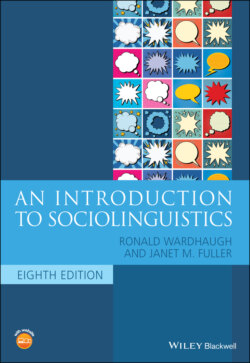Читать книгу An Introduction to Sociolinguistics - Ronald Wardhaugh, Janet M. Fuller - Страница 80
Iconicity, erasure, and recursivity
ОглавлениеA framework for the study of language ideologies was proposed by Gal and Irvine (1995) in which they outline the concepts of iconicity, erasure, and recursivity. The relationship between language and social groups is seen as iconic: language does not just index a social group (as discussed in the last chapter) but is perceived as sharing features with it. For example, in Dickinson’s (2010) research in the Zakarpattia region, she notes that although this region was recognized as part of the Ukraine, it was also viewed as a wild and foreign ‘other.’ Descriptions of the dialect of this region by outsiders always included reference to indecipherable words for everyday objects, and in this way the ‘otherness’ of the language depicted the ‘otherness’ of the people.
Erasure occurs when certain information about languages is ignored in order to support a particular ideology. An interesting example of this is provided by Alfaraz (2018) in a study of language ideologies in the Cuban diaspora. She found that while Cuban Spanish had high prestige in the diaspora, Spanish spoken in Cuba was stigmatized. The study showed that the participants could not actually distinguish between the two varieties but assumed that speakers using nonstandard features were from Cuba. Further, if they were told that speakers were from Cuba and not the diaspora, they rated these voices as less standard, regardless of the actual features which were used in the sample. Thus, the linguistic reality was entirely erased by these speakers; they ignored the linguistic features and assumed standardized speech for the diaspora speakers. This erasure allowed them to maintain the ideology of the superiority of the Spanish spoken in the diaspora over that spoken in Cuba.
Finally, relationships between languages are recursive, meaning that they are repeated on different linguistic levels. For example, the hierarchical relationship between English and indigenous and immigrant languages in the US is replicated between dialects. That is, while English is seen as superior to other languages (supported by a monoglossic ideology), the standard language ideology reinforces this same hierarchical order with English varieties. Thus the standard – that is, some idealized standardized variety of English – is seen as superior to regional, ethnic, or social‐class varieties.
